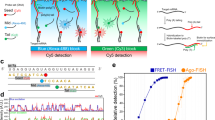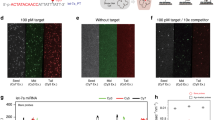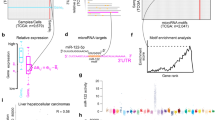Abstract
Microarray technology is a powerful high-throughput tool capable of monitoring the expression of thousands of small noncoding RNAs at once within tens of samples processed in parallel in a single experiment. To conduct a genome-wide analysis of miRNA expression of normal and disease samples, such as cancer, and to distinguish expression signatures associated with diagnosis, prognosis and therapeutic interventions, we have developed a unique miRNA microarray assay on a CodeLink platform. The miRNA array consists of 4,104 probes printed in duplicate. This array can simultaneously profile more than 1,500 mature miRNAs and their corresponding precursors from 474 human and 373 mouse miRNA genes. The full protocol details of the miRNA microarray assay developed by our group are described here, including miRNA oligo probe design, array fabrication and miRNA target preparation (by reverse transcription of total RNA), target-probe hybridization on array, signal detection and data analysis. The assay is simple, can be easily standardized and allows the reproducible profiling of up to 24 total RNA samples within 24 h.
This is a preview of subscription content, access via your institution
Access options
Subscribe to this journal
Receive 12 print issues and online access
$259.00 per year
only $21.58 per issue
Buy this article
- Purchase on SpringerLink
- Instant access to full article PDF
Prices may be subject to local taxes which are calculated during checkout







Similar content being viewed by others
Accession codes
References
Ambros, V. MicroRNA pathways in flies and worms: growth, death, fat, stress, and timing. Cell 113, 673–676 (2003).
Bartel, D.P. MicroRNAs: genomics, biogenesis, mechanism, and function. Cell 116, 281–297 (2004).
Griffiths-Jones, S. et al. miRBase: microRNA sequences, targets and gene nomenclature. NAR Database Issue, D140–D144 (2006).
Bentwich, I. et al. Identification of hundreds of conserved and nonconserved human microRNAs. Nat. Genet. 37, 766–770 (2005).
Lu, J. et al. MicroRNA expression profiles classify human cancers. Nature 435, 834–838 (2005).
Liu, C.G. et al. An oligonucleotide microchip for genome-wide microRNA profiling in human and mouse tissues. Proc. Natl. Acad. Sci. USA 101, 9740–9744 (2004).
Hammond, S.M. MicroRNAs as oncogenes. Curr. Opin. Genet. Dev. 16, 4–9 (2006b).
Kim, V.N. & Nam, J.W. Genomics of microRNA. Trends Genet. 22, 165–173 (2006).
Thomson, J.M., Parker, J., Perou, C.M. & Hammond, S.M. A custom microarray platform for analysis of microRNA gene expression. Nat. Methods 1, 47–53 (2004).
Schmittgen, T.D. et al. A high-throughput method to monitor the expression of microRNA precursor. Nucleic Acid Res. 32, 43–53 (2004).
Chen, C. et al. Real-time quantification of microRNAs by stem-loop RT-PCR. Nucleic Acids Res. 33, e179 (2005).
Raymond, C.K. et al. Quantitative primer-extension PCR assay for direct monitoring of microRNAs and short-interfering RNAs. RNA 11, 1737–1744 (2005).
Cummins, J.M. et al. The colorectal microRNAome. Proc. Natl. Acad. Sci. USA 103, 3687–3692 (2006).
Volinia, S. et al. A microRNA expression signature of human solid tumors defines cancer gene targets. Proc. Natl. Acad. Sci. USA 103, 2257–2261 (2006).
Iorio, M.V. et al. MicroRNA signature in human ovarian cancer. Cancer Res. 67, 8699–8707 (2007).
Calin, G.A. et al. MicroRNA profiling reveals distinct signatures in B cell chronic lymphocytic leukemias. Proc. Natl. Acad. Sci. USA 101, 11755–11760 (2004).
Calin, G.A. et al. A microRNA signature associated with prognosis and progression in chronic lymphocytic leukemia. N. Engl. J. Med. 353, 1793–1801 (2005).
Roldo, C. et al. MicroRNA expression abnormalities in pancreatic endocrine and acinar tumors are associated with distinctive pathological features and clinical behavior. J. Clin. Oncol. 24, 4677–4684 (2006).
Yanaihara, N. et al. microRNA signature in lung cancer diagnosis and prognosis. Cancer Cell 9, 189–198 (2006).
Bejerano, G. et al. Ultraconserved elements in the human genome. Science 304, 1321–1325 (2004).
Xie, X. et al. Systematic discovery of regulatory motifs in human promoters and 3′ UTRs by comparison of several mammals. Nature 434, 338–345 (2005).
Altuvia, Y. et al. Clustering and conservation patterns of human microRNAs. Nucleic Acids Res. 33, 2697–2706 (2005).
Berezikov, E. et al. Phylogenetic shadowing and computational identification of human microRNA genes. Cell 120, 21–24 (2005).
Bolstad, B.M. et al. A comparison of normalization methods for high density oligonucleotide array data based on variance and bias. Bioinformatics 19, 185–193 (2003).
Gentleman, R.C. et al. Bioconductor: open software development for computational biology and bioinformatics. Genome Biol. 5, R80 (2004).
Calin, G.A. et al. Frequent deletions and down-regulation of micro-RNA genes miR15 and miR16 at 13q14 in chronic lymphocytic leukemia. Proc. Natl. Acad. Sci. USA 99, 15524–15529 (2002).
Iorio, M.V. et al. microRNA gene expression deregulation in human breast cancer. Cancer Res. 65, 7065–7070 (2005).
Calin, G.A. et al. Ultraconserved regions encoding ncRNAs are altered in human leukemias and carcinomas. Cancer Cell 12, 215–229 (2007).
Acknowledgements
Dr. Calin is supported by the CLL Global Research Foundation and, in part, as a University of Texas System Regents Research Scholar and as a Fellow of The University of Texas MD Anderson Research Trust, and Drs. Liu and Croce are supported by Program Project Grants from the National Cancer Institute. We apologize to our colleagues whose work was not cited due to space limitations.
Author information
Authors and Affiliations
Corresponding author
Rights and permissions
About this article
Cite this article
Liu, CG., Calin, G., Volinia, S. et al. MicroRNA expression profiling using microarrays. Nat Protoc 3, 563–578 (2008). https://doi.org/10.1038/nprot.2008.14
Published:
Issue Date:
DOI: https://doi.org/10.1038/nprot.2008.14



